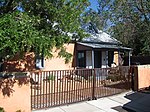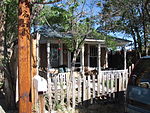Chester Carnes House
1923 establishments in New MexicoHouses completed in 1923Houses in Albuquerque, New MexicoHouses on the National Register of Historic Places in New MexicoMediterranean Revival architecture in New Mexico ... and 3 more
National Register of Historic Places in Albuquerque, New MexicoNew Mexico Registered Historic Place stubsNew Mexico State Register of Cultural Properties

The Chester Carnes House is a historic house in Albuquerque, New Mexico. It was built in 1923 by Lembke Construction for Chester Carnes, an optometrist who was the president of the New Mexico Optometric Association, his wife Helen, and their three sons. It was designed in the Mediterranean Revival architectural style. It was listed on the New Mexico State Register of Cultural Properties in 1979 and the National Register of Historic Places in 1980.
Excerpt from the Wikipedia article Chester Carnes House (License: CC BY-SA 3.0, Authors, Images).Chester Carnes House
Marble Avenue Northwest, Albuquerque Old Town
Geographical coordinates (GPS) Address Nearby Places Show on map
Geographical coordinates (GPS)
| Latitude | Longitude |
|---|---|
| N 35.093888888889 ° | E -106.66 ° |
Address
Marble Avenue Northwest 1260
87102 Albuquerque, Old Town
New Mexico, United States
Open on Google Maps








